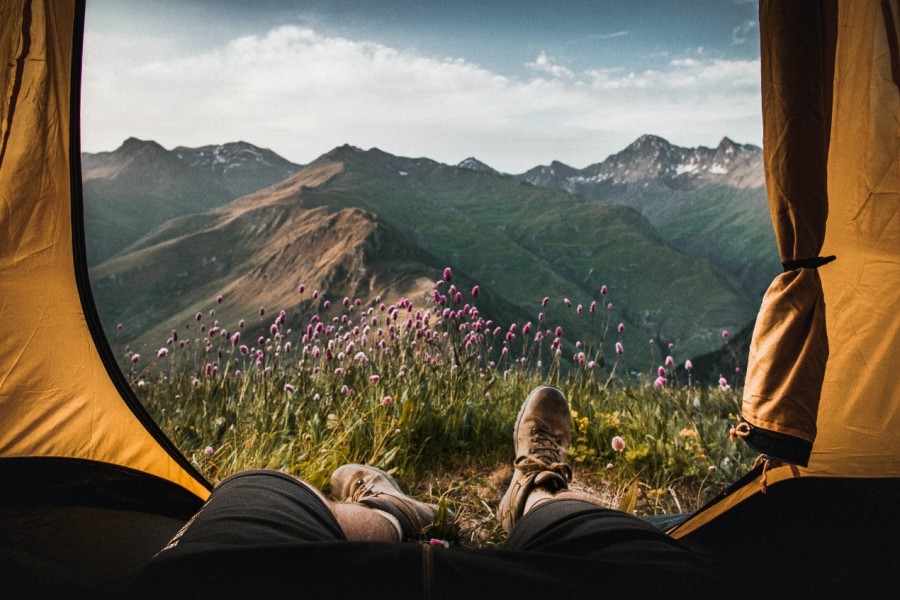Dispersed Camping California
Jin - April 2, 2021
If you’re looking for the best places to do some dispersed camping in California, read on to learn more. There is no shortage of beautiful spots to freely camp, spanning Northern to Southern California. Ready for an adventure in the great outdoors? Sweet. The post will detail:
- What is dispersed camping?
- Top 5 spots in California for dispersed camping
- How to find campsites
- How to be a good dispersed camper
Let’s go!
_______________________
Google Sheets, meet Google Maps

7-day free trial, learn more here!
_______________________
What is dispersed camping?
Simply put, dispersed camping is camping on public lands away from developed recreational facilities. It’s also sometimes referred to as “boondocking”. Essentially, you camp without the typical amenities like water spigots, picnic tables, bathrooms, etc.
The “public land” part of dispersed camping is also important to its definition. Public lands are areas of land that are open to the public and managed by the government. You can think of it as land that you can use and share with everyone else.
What are some examples of public lands? These are lands managed by agencies like the National Forest Service and the Bureau of Land Management (also known as BLM). Those are the agencies that manage the most amount of land in the U.S. Where would some of these spots be in California? I’m glad you asked.
Top 5 spots for dispersed camping in California
Southern California is popular for dispersed camping in 3 locations: Anza Borrego Desert State Park, the Mojave National Preserve, and Joshua Tree National Park.
1. Anza Borrego
This park is approximately a 2 hour drive to the northeast of San Diego and is the largest state park in California. The environment includes lots of dirt roads, lots of hiking trails, mountains and hills, desert terrain, rock formations, and colorful badlands. As far as the wildlife, you may see bighorn sheep, mountain lions, mule deer, jackrabbits, gold eagles and yes, also rattlesnakes. I think pictures would do a much better job of describing what the park is like.




Those dinosaurs are actual sculptures sprinkled around the park. When pictures don’t do it, try this video:
The seven locations recommended in the video are:
- Font's Point
- Clark's Dry Lake Bed
- Borrego Palm Canyon
- Galleta Meadows Sculptures
- The Slot
- Arroyo Tapiado Mud Caves
- Goat Canyon Trestle
While not all of these are free, dispersed camping spots, these are locations where you can hike and explore while you’re at Anza Borrego.
Ground fires are not permitted anywhere in Anza Borrego State Park. A metal ring or container must be used for all campfires. You’ll need to bring your own containers and firewood.
2. The Mojave National Preserve
At 1.6 million acres, the Mojave National Preserve is the third largest unit of the national park system in the contiguous U.S. and is under the jurisdiction of the BLM. It is roughly 1 hour south of Las Vegas by car, right at the edge of Southern California.
Incredible rock formations dot the landscape. This preserve has lots of mountains to trek and also sand dunes to hike. Impressive Joshua tree forests are found in parts of the preserve as well, and some of these forests are the densest in the world. You can also explore a ghost town called Kelso that used to be a railroad depot. Let’s check out some pictures.



This YouTube video also shows many of the beautiful spots that you can check out at the Mojave National Preserve.
Some locations mentioned in the video are:
- Mitchell Caverns
- Cinder Cone Field
- Kelso Dunes
- Afton Canyon
- Zzyzx (that’s an interesting name)
- Evening Star Mine
3. Joshua Tree National Park
This park is named for the yucca brevifolia plant, AKA the Joshua tree, that is native to the Mojave desert and is located roughly 2 and a half hours east of Los Angeles. This is a very popular park that has a cult-like fanbase. Some of the awesome activities you can do here include rock climbing, bird watching, hiking, star-gazing, and of course, camping. Check out these enticing pictures:


Here’s a YouTube video that details the many spots you can enjoy in Joshua Tree National Park.
The locations detailed in the video are:
- Arch Rock
- Cholla Cactus Garden
- Ryan Mountain
- Barker Dam
- Wall Street Mill
- Keys Desert Queen Ranch
- Rocks - Skull Rock, Heart Rock, Split Rock, Cap Rock, Penguin Rock
- Hidden Valley
- Lost Horse Mine
- Keys View
- Geology Tour Road
- Mastodon Peak
- Desert Queen Mine
- Samuelson Rocks
- Eagle Cliff Mine
As far as dispersed camping goes, the Bureau of Land Management offers free camping near the park's south and north entrance. The northern site is near the small town of Joshua Tree, and the southern site is near Cottonwood Springs.
Switching gears to Northern California, two popular dispersed camping locations are Lassen National Forest and Klamath National Forest.
4. Lassen National Forest and Lassen Volcanic National Park
The Lassen National Forest is roughly 3.5 hours north of Sacramento, CA. Within the national forest boundaries, you can prospect for minerals, ride horses, fish, hike, explore caves, and more.
Nearby, at about an hour away, is the Lassen Volcanic National Park where there’s a whole bunch of other awesome spots including more lakes, sulfur vents, mud pots, and Lassen Peak (an active “plug dome” volcano).
The forest has lots of plant life and wildlife abound like black bear, coyotes, mule deer, skunks, woodpeckers.
The landscape of the forest and the volcano area around it include two major river systems as well as many lakes, cinder cones, rivers, and lava flows. If a picture is worth a thousand words, here are a few thousand.



Here is a YouTube video of Lassen Volcanic Park:
Where can you camp for free around Lassen National Forest? Here are a few spots:
- Hat Creek (Lat: 40.6272748, Long:-121.4662703)
- Butte Creek in the Eagle Lake Ranger District
- Black Oak Grove, Black Rock Campground, Caribou Wilderness, and High Bridge Campground in the Almanor Ranger District
Check the USDA Forest Service website for more information.
5. Klamath National Forest
With many energetic rivers and peaceful lakes, the Klamath National Forest is a treasure for rafting, boating, fishing, swimming, and white water enthusiasts. Among the rolling hills and rugged mountains, trailheads are numerous and hikes range from easy to pretty difficult.
It is located roughly 5 hours north of Sacramento, CA and is very close to the border of California and Oregon.
You can see a lot of the same wildlife that is around the Lassen National Forest. Check this YouTube video out to see some of the landscapes:
There are many, many locations in the Klamath National Forest for free, dispersed camping. Many of them have river access and trail head access and therefore allow you to camp in solitude while having convenient access to activities nearby. Check the Klamath National Forest dispersed camping website for more info.
How to find dispersed camping sites
Dispersed campsites are located along most dirt roads and may not be marked. It would be wise to have a vehicle capable of traversing off-road, sandy, and potentially soft ground when trying to get to these areas but this isn’t a requirement. The general rule is to camp 100-200 feet away from any trail, road, or body of water.
Popular locations can be determined by the flat ground areas that people have used before although not all flat areas are sites (confusing, I know). Obviously, very useful resources are the U.S. Department of Agriculture Forest Service or Bureau of Land Management websites. However, sometimes the info is difficult to find and while you’re out there, you might not have cell service so I’d highly recommend the following physical books that you could take with you on your adventure: BLM Camping and Camp For Free: Dispersed Camping & Boondocking on America’s Public Lands.
How to be a good dispersed camper
It’s nice to keep the public lands pristine so that other campers and the next generation can enjoy what you’ve enjoyed. Here are some tips to being a courteous and respectful dispersed camper.
- Take your toilet paper with you when you depart and don’t just leave it lying around. Same thing goes for any food waste. If wildlife starts getting used to human food, they may become a nuisance. Just take all your trash with you.
- Don’t start a fire just anywhere. Use existing fire rings or containers instead. If you arrive at a campsite without a fire ring or container, simply don’t start a fire there.
- Don’t drive your vehicle into the wilderness. The wilderness lands are specially protected and the Wilderness Act prohibits wheeled vehicles.
- Don’t leave plastic, even “compostable” plastic bags. People tend to poop into plastic bags and then bury them but that is unnecessary. Just dig a 4-6 inch hole and go about your business. The plastic bags, even when biodegradable or compostable, don't really dissolve well because of the lack of water in the desert. Animals will dig them up and that’s a problem for them and the park employees.
- Always practice Leave No Trace ethics on your adventures!
Conclusion
I hope you found this post helpful for your next outdoor, nature extravaganza. If you have a Prius or a Tesla, check out the Prius camping blog post here and the Tesla camping blog post here. Finally, check out some useful gear to use for your next camping adventure.
- Northface Eco Trail Sleeping Bag (for a comfortable, warm night's sleep. aahhhhh…)
- Wellax Sleeping Pad (for your car or tent)
- Sunnydaze Fire Ring (for containing your fires)

